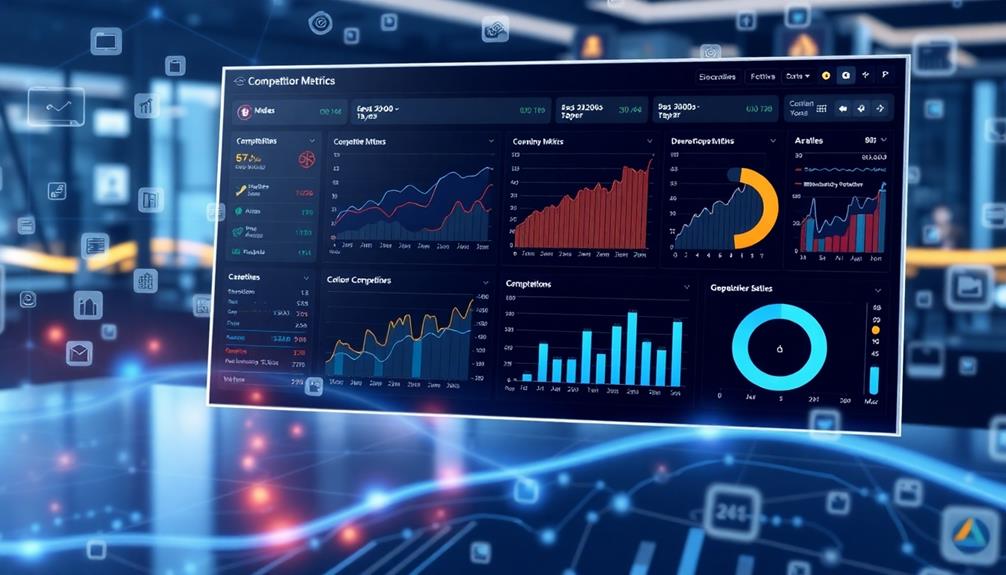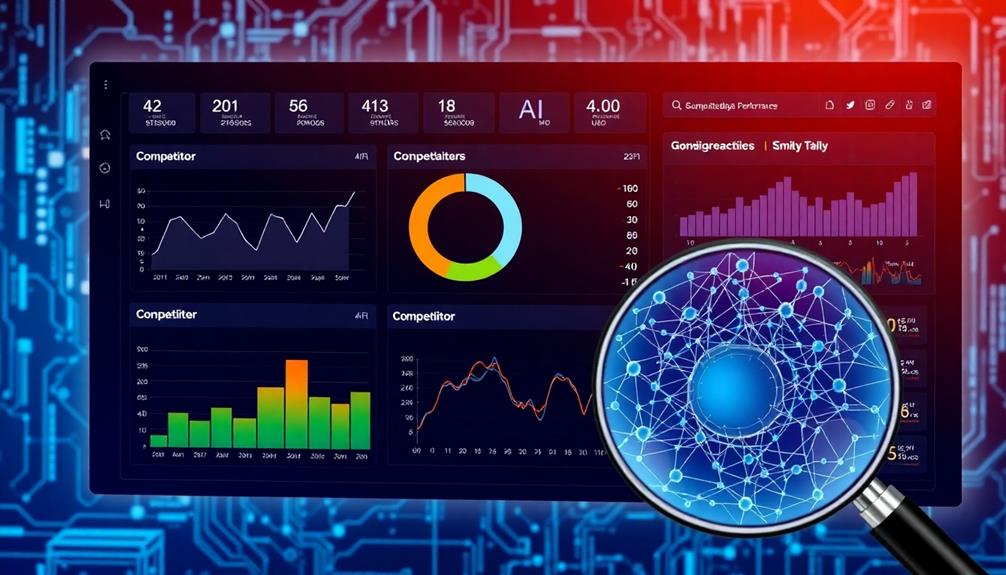You can use AI for competitor analysis in various impactful ways. First, automate data collection to gather insights without manual errors. Leverage dynamic competitor monitoring to track real-time activities and sentiment analysis to gauge brand perception. Next, benchmark your performance metrics against competitors to identify strengths and weaknesses. Incorporate risk management strategies to anticipate market fluctuations. Use automated reporting solutions to save time on generating insights. Finally, create automated dashboards for an all-encompassing view of competitive dynamics. Each technique will enhance your strategy and effectiveness; stay tuned to explore how they work in more detail.
Key Takeaways
- Utilize AI-driven web scraping tools for efficient and error-free automated data collection from competitors' online sources.
- Implement automated reporting solutions to quickly generate insights on market share, audience demographics, and competitor pricing.
- Conduct dynamic competitor monitoring to track real-time activities such as pricing changes and product launches across multiple platforms.
- Leverage sentiment analysis tools to assess customer feedback and gain insights into brand perception relative to competitors.
- Employ performance benchmarking tools like SEMRush and Ahrefs to compare KPIs and identify areas for improvement against industry standards.
Automated Data Collection

Utilizing AI-driven web scraping tools, businesses can efficiently collect data from various online sources, including competitors' websites and social media platforms. This automated data collection greatly streamlines your competitor analysis process, allowing you to analyze large volumes of information without the manual effort and errors that traditional methods often bring.
AI tools continuously gather data, delivering real-time insights into market trends and competitor activities. By leveraging these advanced systems, you can monitor customer sentiment and engagement levels, gaining an all-encompassing understanding of how your competitors are perceived in the marketplace.
Tools like Determ and BuzzSumo excel at this, providing you with crucial information that can inform your strategic planning. With automated systems, you can aggregate competitor data into centralized repositories like Google Sheets or Airtable, making it easier to identify patterns and make informed decisions.
This capability not only enhances your ability to respond promptly to competitor strategies but also guarantees you maintain a competitive advantage in a rapidly changing environment. Embracing AI-driven automated data collection is critical for staying ahead in today's dynamic market landscape.
Competitive Sentiment Analysis

Competitive Sentiment Analysis
After automating data collection, the next step is to analyze how customers perceive your competitors through competitive sentiment analysis. This technique utilizes natural language processing (NLP) algorithms to categorize customer feedback into positive, negative, or neutral sentiments, providing valuable insights into brand perception.
As highlighted in AI's transformative role, leveraging AI enables businesses to gain a competitive edge by understanding customer dynamics in real-time. With the help of machine learning models, you can recognize context and nuances in customer feedback, leading to a deeper understanding of customer satisfaction and areas needing improvement.
For example, sentiment analysis can compare customer sentiment for brands like Papa John's against its competitors, revealing their strengths and weaknesses in customer experiences. This analysis not only highlights what customers appreciate but also points out aspects that may require attention.
AI algorithms automate the comparison of key performance indicators (KPIs) across competitors, enabling you to assess your market position more effectively. By identifying focus channels through sentiment analysis, you can make informed strategic decisions that enhance your marketing and product development efforts.
Ultimately, leveraging competitive sentiment analysis empowers you to stay ahead in the market by aligning your strategies with customer expectations and continuously improving your offerings.
Dynamic Competitor Monitoring

Staying on top of your competitors is essential in today's fast-paced market, and dynamic competitor monitoring makes that easier than ever. By leveraging AI-driven web scraping tools, you can continuously collect data from various sources, including competitors' websites, social media, and news articles. This approach allows you to maintain up-to-date insights on competitive dynamics and conduct thorough competitive research.
Additionally, utilizing AI in Business techniques enhances your ability to automate support and streamline feedback collection, providing an all-encompassing view of your competitive landscape.
With real-time monitoring capabilities, you can track competitor activities, such as pricing changes and product launches, enabling timely strategic responses. Automating data collection processes not only reduces manual effort but also minimizes errors, increasing your efficiency in gathering essential market intelligence.
Moreover, AI tools can help you analyze competitors' online activities and social media engagement to identify trends that inform your marketing strategies effectively. Continuous competitor monitoring facilitates early detection of shifts in market positioning and emerging threats, empowering you with the information needed for proactive decision-making.
Risk Management Strategies

As you keep a close eye on competitors, it's equally important to implement effective risk management strategies. By leveraging AI in your competitor analysis, you can analyze economic indicators and market trends to identify potential risks early. This proactive approach allows you to adjust strategies before challenges arise.
AI-driven insights into competitor behavior enhance your ability to anticipate market fluctuations. Machine learning models can reveal patterns and trends that help you mitigate risks, giving you a competitive edge.
Additionally, using AI tools to monitor public perception can highlight reputational risks associated with your competitors, enabling you to manage your brand effectively.
Early detection of risks through AI analytics means timely intervention, reducing the impact of unforeseen challenges on your operations. By enhancing your decision-making processes with data-driven insights, you can refine your risk management strategies, boosting your organization's resilience in uncertain environments.
Integrating these AI techniques into your competitor analysis not only safeguards your business but also positions you to seize opportunities that may arise from market changes.
Take charge of your risk management today to stay ahead in the competitive landscape.
Benchmarking Performance Metrics

When you're benchmarking performance metrics, it's all about comparing your key performance indicators (KPIs) with those of your competitors.
By leveraging real-time data analysis, you can quickly spot areas where you excel or fall short.
This insight not only sharpens your competitive edge but also helps you make informed decisions moving forward.
Key Performance Indicators
How can you effectively measure your company's success against competitors? By leveraging Key Performance Indicators (KPIs), you can gain actionable insights into how your business stacks up in the market. Common KPIs like revenue growth, customer acquisition cost, and market share are vital metrics to keep an eye on during your competitive analysis.
Benchmarking these performance metrics against competitors helps identify areas for improvement and reveals valuable insights into industry standards. Utilizing research tools such as SEMRush and Ahrefs allows you to monitor your SEO performance, focusing on organic traffic, keyword rankings, and backlink profiles.
Don't overlook sentiment analysis as a significant KPI. It measures customer perceptions and satisfaction levels, offering insights into how your brand is viewed relative to competitor strategies. This can notably affect your overall market positioning.
A study found that organizations employing competitor benchmarking reported a 10-20% improvement in performance metrics, underscoring the importance of understanding competitive dynamics.
Real-Time Data Analysis
Real-time data analysis is essential for staying ahead in the competitive landscape, allowing your business to swiftly adapt to market shifts. Utilizing AI tools, you can continuously monitor performance metrics like website traffic, social media engagement, and customer sentiment. This proactive approach in competitor analysis helps you identify trends and adjust your strategies accordingly.
Platforms such as SEMRush and Ahrefs provide benchmarking capabilities, comparing your key performance indicators (KPIs) against those of your competitors. This insight reveals strengths and weaknesses in your SEO strategies, guiding your efforts effectively.
Machine learning algorithms can also analyze historical performance data to forecast future trends, empowering you to make data-driven decisions regarding marketing and product positioning.
Moreover, sentiment analysis tools assess real-time customer feedback, offering a glimpse into your competitors' reputations and highlighting areas needing improvement. Automated dashboards consolidate various performance metrics, giving you a thorough view of competitive dynamics.
This guarantees you can respond timely to emerging opportunities or threats, keeping your business agile in a fast-paced environment. Embracing real-time data analysis positions you for success in maneuvering the complexities of today's market.
Automated Reporting Solutions

Automated reporting solutions leverage AI to streamline the process of competitive analysis, saving you valuable time and resources. By utilizing AI-driven platforms, you can gather and analyze competitive data in real-time, greatly reducing the time spent on manual reporting processes. Tools like Competely and ClickUp can generate thorough competitor analysis reports within minutes, giving you insights into market share, audience demographics, and pricing strategies.
Here's a quick overview of the benefits:
| Feature | Description |
|---|---|
| Customizable Reporting | Define specific parameters for tailored insights. |
| Continuous Monitoring | Stay updated on competitor activities and market trends. |
| Enhanced Accuracy | Reduce human error and identify emerging trends. |
Implementing automated reporting allows you to continuously monitor competitors, enabling timely adjustments to your strategic plans. With these solutions, you can make data-driven decisions and stay ahead of the curve in a dynamic market. Embrace these technologies to transform your competitor analysis process and enhance your overall business strategy.
Frequently Asked Questions
How Can AI Be Used to Do Competitor Analysis?
You can leverage AI for competitor analysis by automating data collection, analyzing sentiment, and benchmarking performance. Tools like SEMRush help you identify SEO opportunities, keeping you informed about competitors' strategies and market dynamics.
What Is Gen AI for Competitor Analysis?
Generative AI for competitor analysis helps you gather and analyze data quickly. You can identify competitor strategies, interpret customer feedback, and generate reports, all while staying updated on market trends and real-time changes effortlessly.
Can Chatgpt Do a Competitor Analysis?
Think of ChatGPT as your strategic compass. Yes, it can perform a competitor analysis, synthesizing data on market dynamics, customer sentiment, and product offerings to help you navigate your competitive landscape effectively and inform your decisions.
What Are the 4 Competitor Analysis?
You should focus on four key areas for competitor analysis: market positioning, product offerings, marketing strategies, and sentiment analysis. These aspects help you understand competitors and refine your own business strategies effectively.
Conclusion
By tapping into these six techniques, you can stay a step ahead of the competition and make informed decisions. Utilizing AI for competitor analysis isn't just about gathering data; it's about turning insights into action. With the right tools, you'll be able to navigate the competitive landscape like a ship sailing smoothly through stormy seas. Don't wait for the tides to change—embrace AI and watch your business thrive in even the choppy waters of your industry!










